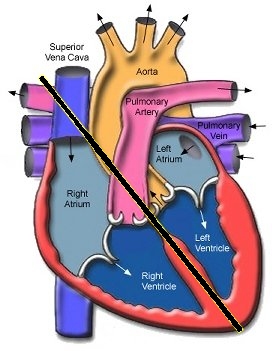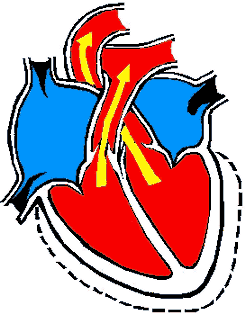
Inside the Heart
The heart can be thought of as having a left and right-hand side, with each side acting as a seperate pump.
The right-hand side receives used blood from the body tissues returning to the heart via the veins, and then sends it back to the lungs to replenish the oxygen.
The left-hand side receives blood replenished with oxygen from the lungs, and pumps it around the body
Left & Right sides are divided into an upper chamber called an Atrium and a lower chamber called a Ventricle, thier being four separate chambers in total.
Atria are where the blood returning to the heart from the veins is collected.
Ventricles are where the blood is pumped back into the arteries. The left ventricle is the largest and most muscular of all the chambers, as it has the job circulating the blood around the body.

The beating of the heart is basically in two parts (or phases).
The first part is as the heart starts to contract.
This is called Systole phase of the beat.
The contraction starts at the top of the heart in the atria. Blood is forced from the atria into the ventricles. As the contraction contiues the ventricles contract and blood is forced out of the heart and into the arteries.
The heart then relaxes, this is the Distole phase.
As the heart relaxes the atria re-fill with blood flowing back into the heart via veins. It is then ready for the next contraction.
For most people it will continue to do so 24 hours a day 365 days a year, for 70-80 years. At rest the heart pumps around 5 litres of blood around the body each minute. When working hard during execise it may pump as much as 30 litres a minute around the body.